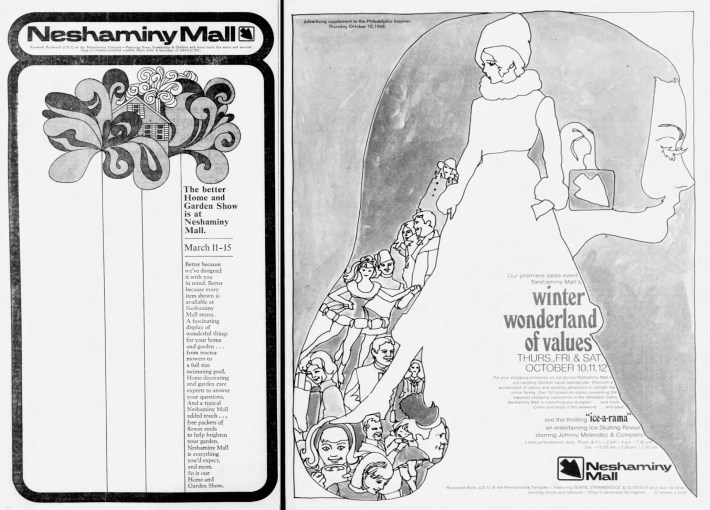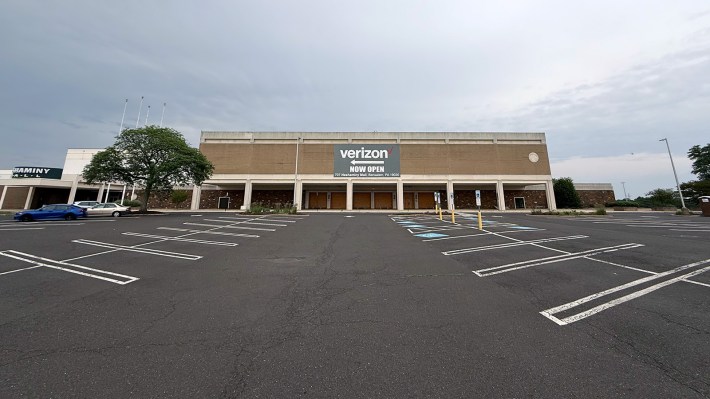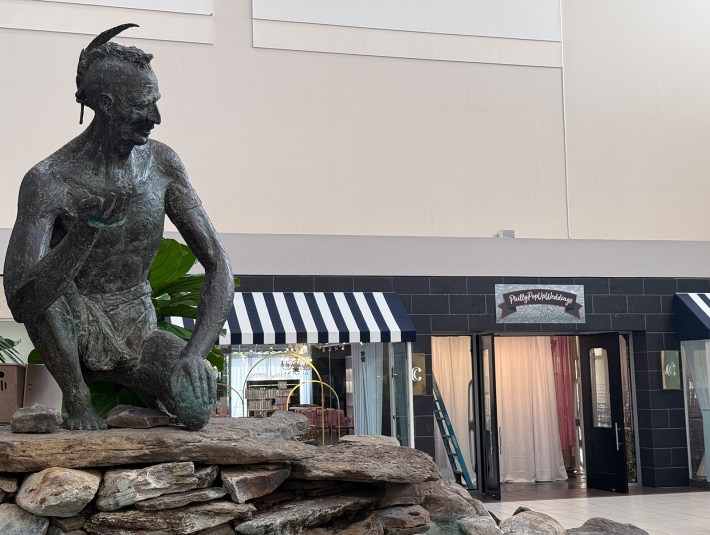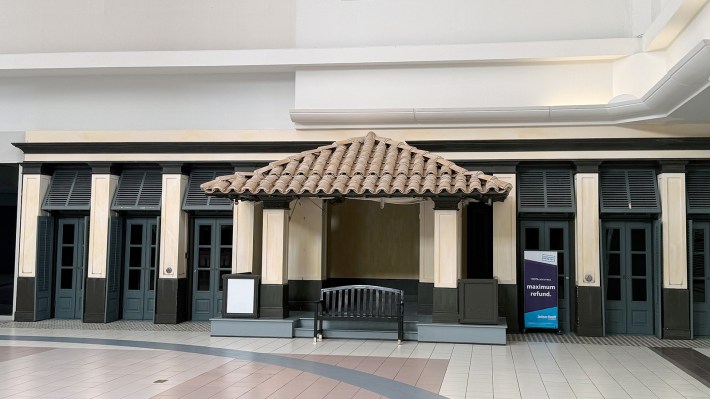The vote looked like a funeral. Residents showed up to the council meeting dressed in black, carrying prop tombstones. One carried drooping flowers. “I feel that what the council has just done has sentenced us to a long, agonizing death,” she said. “We’re disgusted,” said another protester. Dire predictions had been made at earlier hearings. “I’m embarrassed to say I live in Bensalem,” one woman told the council. “Do you know why? Because of what we’ve let it become.”
It was 1997. The issue at hand in Bensalem Township, Penn., was the construction of an $11 million, 24-screen movie theater at the Neshaminy Mall. The township’s planning commission had rejected the proposal. Residents of the nearby Belmont Hills neighborhood were concerned about increased crime and traffic. The arguments got a little esoteric. “When Arnold Schwarzenegger finishes saving the world, some rowdy people will come out of the theater spinning their wheels, and crime will inevitably occur,” said the town watch co-chair. A planning commission board member wondered why anyone would even go to a theater: “Why should you get in your car and face all that traffic and all that aggravation just to see a movie?”
“I was going to give you a frequent movie card,” an AMC rep replied. “I guess I won’t do that now.” Township public safety director Francis Friel wasn’t worried: “There’s no correlation between movies and crime.” Representatives from General Growth Properties, which owned the mall, said the theater was necessary for the mall’s survival. The zoning board chair agreed, but said the neighbors’ concerns were more important than the mall. It’d be OK if it failed. “Within five to 10 years you may be looking at a ghost mall,” he said. “That’s the price you have to pay.”
They fought the mall, and the mall won. Council approved the movie theater. It opened. It held off things for a long while, but in 2025 the “ghost mall” prediction came true anyway: The Neshaminy Mall is dead. It’s going to close.
Here is my favorite memory from the Neshaminy Mall movie theater: In the year 2000, my friends and I couldn’t agree on a movie. It might’ve gotten heated; we were seniors in high school. We eventually decided to split up. Half of us would see Pitch Black; the other would see another film. I saw Pitch Black, the Vin Diesel sci-fi movie that launched the Chronicles of Riddick series. I hated it. The only thing I remember about the movie is that I hated it. We all hated it. Someone in our group came up with the idea that we’d pretend we liked it. Meanwhile the other group was coming up with the same plan; they’d hated their movie too.
Our respective ruses lasted about a minute. Both groups were trying to declare that they’d made the right choice. I remember the moment when a guy in my group snapped. “OK, we hated it! We just wanted to pretend we did!” A friend in the other group shouted back, “We hated our movie too!”
The movie theater seemed like a dream to me. There weren’t many other places for teens to hang at night: Parents’ basements, malls, diners, bowling, Wawa parking lots (until being asked to leave by an employee), playgrounds (until being told to leave by a cop). In 1998, I was 15. Some friends had started to get drivers’ licenses. We had a whole new place to hang: a 24-screen behemoth with stadium seating and, per AMC, 4,900 “LoveSeats.” It was the most comfortable movie theater I’d ever been in.
The Neshaminy Mall opened in 1968 on a former cornfield just outside of Philadelphia. It was a good spot, built to serve the Northeast’s growing communities, as well as those in Lower Bucks County. It was basically right where the Pennsylvania Turnpike meets U.S. Route 1. Victor Gruen Associates, the eponymous firm of the architect who designed the first enclosed shopping mall in the United States, handled design. Development was managed by two Philly companies: Hyman Korman, and Strouse Greenberg & Co. Korman was instrumental in the post–World War II transformation of once-rural Far Northeast Philadelphia. I grew up in a red-brick Korman house in the Far Northeast originally marketed as Pennswood, a name no one actually used. “Don’t let your husband tell you that you can’t buy a new home right now,” one 1966 ad read.
By the late ’60s, Korman was also expanding into nearby suburbs. Gruen’s original plans for the first enclosed mall, the Southdale Center in Edina, Minn., had included “apartment buildings, houses, schools, a medical center, a park, and a lake.” These never materialized at Southdale. Korman leaned into Gruen’s ideas a bit more: It was building residences around the same time Neshaminy went up.
Korman’s plan was to build a “total community” in conjunction with the mall. Much like with the movie theater, neighbors were unhappy. “Such apartments would not be an asset to the community,” a Belmont Hills resident said. “They would bring city conditions here.”
The enclosed mall, the Philly area’s sixth, opened in 1968. It had the largest Sears in the Philadelphia area, plus a Strawbridge’s department store featuring an animated historical display called The Freedom Wall. In 1970 the mall added a Henry Mitchell sculpture, the Neshaminy Indian, that became its best-known symbol. The mall had a vague Native American motif: Its sign was a totem pole, its logo an arrowhead. Strawbridge’s had a restaurant that overlooked the courtyard with Mitchell’s sculpture.

Just four years after Neshaminy opened, the owners sensed trouble. Another mall, Oxford Valley, was opening farther up Route 1. It would be newer, but more importantly it would be bigger: The entire mall would be two stories, instead of just anchor stores getting another level. Neshaminy planned to hold more events, upped its marketing budget by 40 percent, and eventually added a Macy’s and a Pomeroy’s department store; the latter survived other Philly-area store closings, but was eventually sold to Boscov’s in 1986.
The late 1980s brought another challenge in nearby Northeast Philly: Franklin Mills. This opened when I was 6 years old, and I always struggle to convince people what a big deal it was. Here is what I’ve come up with: Fucking Ella Fitzgerald sang at the opening. Busloads of tourists came in to shop. The sprawling complex, on the grounds of the former Liberty Bell Park harness racetrack, also had the first U.S. location of French hypermart Carrefour. There was a giant Benjamin Franklin head in the center court. Fucking Milton Glaser did its design work. F-bombs have also helped me explain how big Franklin Mills was.
I lived closer to Franklin Mills. It was bigger. It was cheaper. There was a giant arcade, the 49th Street Galleria. There were two food courts. It had a 10-screen movie theater, in contrast to Neshaminy’s then-two screens. I spent much of sixth through eighth grade there. It ate other shopping nearby. The Woodhaven Mall, at most five minutes away by car, closed; in 1993, it became a regular ol’ shopping center with an expanded movie theater. Neshaminy had new plans: It expanded its food court and built the largest movie theater in the area.

Last month, I went mallwalking. It was hot out, I was at my parents’ house, and I was up for nostalgia. “Just know,” my mom said, “you won’t see anyone else.” She was only exaggerating a little. There are malls that are middling and malls that are dying and there are malls that are dead.
Two anchors—a Barnes & Noble where the pet store used to be, and a neon-clad Boscov’s with an enormous novelty T-shirt department—were lively and seemed to be doing well, or at least as well as giant stores selling books and clothes can be doing in 2025. The rest of the mall was virtually empty. One of the storefronts was a church. Another was a wedding venue. “Bringing Vegas services to Philly,” its website reads. There were a smattering of independent shops. The mall lists 24 stores in its mallmanac. (This doesn’t seem to have been updated recently: I did not see a store called Massage Mob, but there were stores named Prom Rack and Popular Silks that are not on the list.)
What struck me was, despite a 2015 renovation, how much the mall was frozen in its late-’90s format. Everything looked the same as it had. Lots of these stores had held on for a bit and were never replaced. It hit home. That empty storefront still looked like a Sam Goody. If I squinted, I could still see Structure. I saw the storefront that was The Deb, where I would spend hours waiting for my girlfriend and our other friends to try on party tops. I once got scolded for taking photos of their looks on a disposable camera.
There were dying mall staples: an ice cream shop that clearly used to be an Auntie Anne’s, the grungy-looking storefront of a since-relocated Hot Topic, the slanted-front windows of The Wall. Time Out arcade still had its design. There’s an outline of the Modell’s on the wall. There is the absurd built-out of a Hollister; a woman who worked there in high school told me the Neshaminy Mall location had the highest shrinkage of any in the chain. Then, there it was: the now-empty restaurant where four Bensalem cops held a sting operation to arrest a woman who posted on Craigslist she might trade sex for World Series tickets. Her conviction was overturned.
The Neshaminy Mall I knew will not be around much longer. Paramount Realty and Edgewood Properties bought it a year ago; the companies plan to demolish about half the mall. Boscov’s, Barnes & Noble, and some restaurants in the parking lot will remain. A gym may move into the former Macy’s. And, yes, the movie theater will be there. There’s no closing date for the mall proper, but the new owners say they will find a use for the sculpture.

I love malls mainly because I am 42, and have had a shopping problem since birth. I am fascinated in the ways that the artificial indoor-shopping mall vendors have to differentiate their offerings within the mall owner’s often-strict rules. The constraints can create freedom. Stepping into a new mall can be an adventure: Stores can be weird, cool, or both. What is the vibe of this mall? What are the unwritten rules? What vulgar T-shirts will be for sale at Spencer’s? Will there be bored old men selling baseball cards? Will there be a cart with a bootleg Nintendo? Will there be a shortcut through the jewelry store, or will they have blocked off the corner with ring cases? Will there be goths?
Go enough times, and you figure it all out. Our trips to Neshaminy generally centered around the movies, but we also just hung out. For me it became not a trip, but a pilgrimage. In A Travel Guide to the Middle Ages, Anthony Bale writes of the Gardens of Maṭariyya, a mostly forgotten Christian holy site in Egypt with powers attributed to the Virgin Mary: “The garden was like an actualization of two of the most celebrated spaces in medieval culture: the hortus conclusus (a walled garden, itself symbolic of the Virgin) and the locus amoenus (an idealized ‘pleasant place’ of recreation and edification).” Yeah. That’s the mall for me. It’s like the Virgin Mary.

While I walked around the mall last month, I took some photos and sent them to a high school friend who had been there that day in 2000. I told her about my favorite mall memory, but I couldn’t remember the film I didn’t see. She remembered: Mission to Mars, a different sci-fi movie with a better cast and (somehow) much worse reviews than Pitch Black. This was a few minutes of our lives 25 years ago. We don’t have all the details, but we remember.
“Where do kids hang out now?” my friend texted. I know teens have a harder time finding places to hang out today—some malls even ban unaccompanied teens (though I’ve been at several malls where that’s unenforced). But places still exist for teens to make lasting memories, even if it comes while playing Bongo Cat. I am just nostalgic for one of mine.
But hey, the Neshaminy movie theater isn’t going anywhere. I do believe the movies remain a decent option for teen hangs. And I have just the suggestion for what to see: a fourth Riddick film, this one chronicling his origin story, is in production. I can’t imagine it will be any good, but there’s a chance you’ll still have a great time.